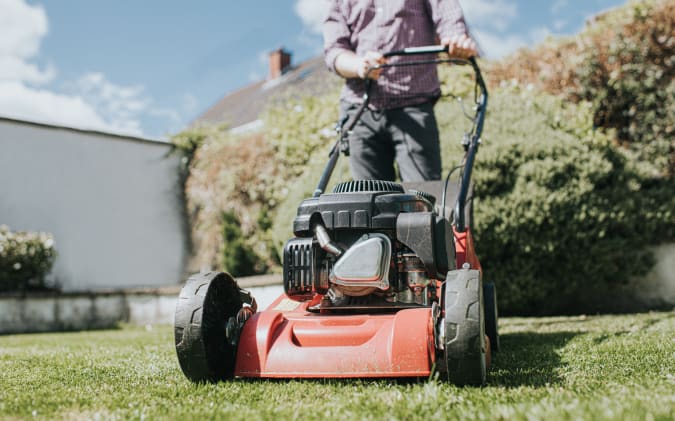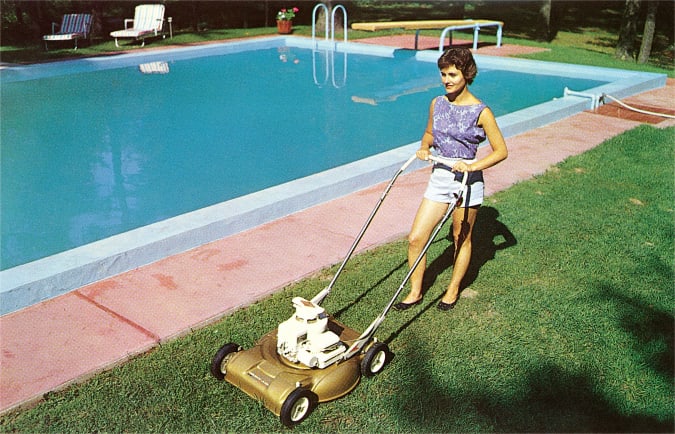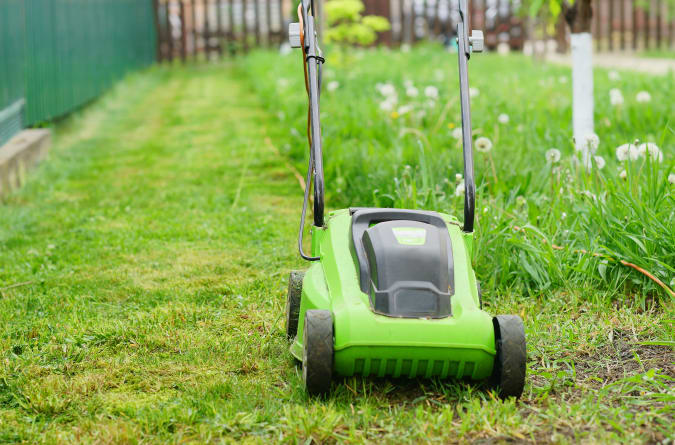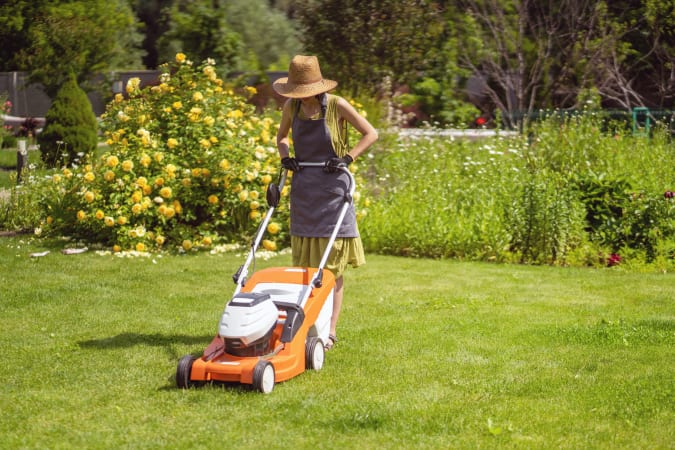The days of the gas-powered lawn mower and leaf blower are numbered in California. Last October, Governor Gavin Newsom signed AB 1346, banning the sale of new gas-powered tools in the state by 2024, akin to its ban on new internal combustion vehicle sales by 2035.
And the Golden State is far from alone, “I think that the easier the manufacturers make it for other states to adopt the same sort of ban, the more states will do it,” University of Southern California environmental law professor Robin Craig told CBS. Lawmakers in Illinois and New York both are seeking to pass similar bills at the state level while cities like Brookline, Massachusetts; Montclair, New Jersey; and Burlington, Vermont, have all independently enacted seasonal bans of their own on gas-powered leaf blowers.
And it’s not just because internal combustion (IC) landscaping equipment is so loud — leaf blowers average 70 dB at 50 feet (the operator hears closer to 95-100 dB) while mowers start at around 85 dB — they are also significant emitters of greenhouse gasses. The California Air Resources Board (CARB) notes that running an IC mower for 1 hour emits the equivalent amount of carbon as driving a 2017 Camry 300 miles from LA to Las Vegas. Operating a 2-stroke leaf blower for the same amount of time produces the same amount of carbon as driving to Denver, roughly 1,000 miles from LA.
Education Images via Getty Images
That’s actually an improvement from what we saw in the ‘80s and ‘90s before California instituted CARB. Today’s small engines are 40 to 80 percent more efficient and cleaner burning than they were before the agency got its start but, regardless, there are still some 16.7 million small (sub-19kW) engines in California — that’s three million more than the number of light duty passenger vehicles currently operating in the state. And given that the average price of a gallon of gas in America is currently $4.37 (the highest since 2000, per AAA), running all those noisy, thirsty mowers and blowers is getting untenably expensive as well.
With a long, hot summer of high gas prices imminent and the writing on the wall for 2-stroke engines, what better time than now to electrify your lawn care equipment? But before you head down to your local home improvement center, here’s some advice on what to look for in an electric mower directly from the people who design them.
Catherine Falls Commercial via Getty Images
Gas or Electric
Much like the auto industry’s ongoing transition from IC engines to EVs, lawn care equipment makers have spent recent years investing heavily in battery-based systems and have seen the performance of these power plants rapidly improve to be practically on par with the gas engines they’re replacing — not to mention being quieter, less expensive to operate and generally better for the environment.
For example, your average electric mower or leaf blower is going to produce around 75 dB of noise (equivalent to a running washing machine) — granted, that’s only a 10dB difference between the gas and electric motors, but because decibels are measured along a logarithmic scale, it actually sounds nearly half as loud to the human ear. And unlike gas mowers, using an electric doesn’t require you to don hearing protection (though safety glasses are always a good idea). What’s more, electric engines (with their decided lack of moving parts) wear much more gently than their internal combustion counterparts: No spark plugs to replace, oil to change, gas-oil ratios to measure and pour.
“Many professional-grade battery-powered tools come equipped with a brushless motor, which is virtually maintenance-free,” Stihl battery product manager, Paul Beblowski, told Engadget via email. “With a battery — there’s no need to buy, transport, or store fuel. There’s no tune-up for an electric motor and no need to winterize.” Aside from sharpening the cutting blade once a season or so, all owners really need to do is ensure the battery gets recharged before their next mowing session.
Found Image Holdings Inc via Getty Images
That’s not to say gas mowers are overnight relics. There are still plenty of use cases in which going with a conventional mower makes more sense, like when you need to clear more than an acre of land, or have to cut through dense, damp underbrush on difficult terrain, or are cutting on a remote field far from power outlets (sit down, Lightning Pro). A given unit of gasoline is still 100 times more energy dense than even the bloodiest-edge battery technology.
When it comes to choosing between a corded versus battery electric mower, “buyers must evaluate the size of their yard, access to outlet, and overall need for convenience,” Beblowski said. “It would make most sense to use a battery-driven mower when there is no access to an outlet or the customer wants the convenience provided by not dragging a cord through their yard. In addition, if the user is mowing around their pool or other water sources, it would make sense to stay away from cords and rely on a battery-driven mower.”
Another thing to consider is that while corded mowers will never run out of power, the amount that they can draw from a standard outlet cannot exceed 15 amps and 1800 watts (15 amps because that’s the US regulation, 1800 watts = 15 amps x 120 volts) — that’s actually the theoretical maximum and will continually throw breakers with that much load, so electric mowers typically top out at 13 amps (and therefore 1500 watts). So, if you’re looking for a heavy duty, high performance mower, especially a riding rig, battery-based systems will largely be your only electrified option.
How electric motors work
Standing in the power tool aisle of your local, prepare to be inundated with signage and branding calling out various aspects of the electric motor’s performance like “13 amps of power!” or “70 minutes of runtime!” These are helpful metrics but can be misleading and finding the right ratio of volts, watts and amps in that electric mower is paramount to getting the most out of your lawn care investment.
Elena Gromova via Getty Images
For those of us that slept through that day of high-school science class, a quick analogy of how electricity works: it’s like plumbing. The given rate of water flowing through a pipe — Wattage, the electrical equivalent of gallons per minute — is determined by the ratio between the water pressure (aka Voltage) and the diameter of the pipe that it’s flowing through (the circuit’s Resistance). If you want to increase the wattage (that is boost the flow of electrons or, by this analogy, have more gallons flow per minute) you either have to increase the water pressure (increase the circuit’s voltage) or widen the pipe (i.e. use a higher amperage wire which lowers resistance).
“A good measuring tool for batteries is watt-hours (comparable to the size of a gas tank),” said Guy Dekowski, Outdoor Senior Product Manager at Dewalt. “Battery watt-hours are battery voltage multiplied by amp hours. This is a good signal of how long the mower can potentially run.”
“It’s important to differentiate between voltage and the amount of work a tool can actually do,” Beblowski said, noting that equating voltage to a motor’s overall power is a common misconception. “While voltage is a factor, the true energy capacity of a battery is measured in watt-hours… the watt-hours tell you the power of the tool. So, if you have an 80-volt system and a 2 Ah battery, you’re looking at 160 watt-hours, but if you have a 36-volt system and a 5 Ah battery, the power is actually higher at 180 watt-hours.”
Unfortunately there is no hard and fast rule governing whether high voltage – low amp tools or low voltage – high amp tools are generally superior. “There are pros and cons to both configurations,” said Dekowski. “Generally higher voltage is capable of more power; however there are variables outside of voltage and current to consider. For example, the deck and blade design have an impact on performance.”
“Hills and the thickness of their grass,” are two yard feature factors users should consider, Dekowski continued. “If a user has an incline, a self-propelled mower may suit them best. The thickness of the grass also plays a factor in the runtime of their mower. In thicker grass, the mower will pull more power driving the need for a mower capable of longer runtime.”
What to look for in an electric mower
The size and shape of your lawn will also impact the size and style of the mower that you need. Pay attention to the mower’s deck size, that indicates how wide of a swath it can clear with each pass. You’ll clear your yard in fewer passes with a 21-inch deck than you will with a 14-inch, though the corollary to that is wider mowers tend to be heavier and less maneuverable than their skinnier counterparts.
If you’ve got a compact urban backyard that needs tending, you can more likely get away with just a small push mower such as the 14-inch Worx 40V, 4Ah Power Share. More expansive suburban yards will do well with a larger, perhaps self-propelled model like the 21-inch Stihl 36V, 6Ah RMA 510 or a 20-inch, 12-amp corded Greenworks mower, while rural homeowners might need something a bit more heavy-duty like Toro’s 21-inch 60V, 6Ah Super Recycler or this 42-inch, 75Ah rideable Ryobi.
“Twenty to 21-inch decks are the most popular for a couple reasons,” Dekowski said. “First, it helps keep the weight at a minimum but the deck is still large enough to minimize work. The other benefits are maneuverability and compactness for storage.”
Like any other tool purchase, when shopping for a new mower try to stick to established, reputable brands like Stihl, Stanley Black and Decker (which owns DeWalt), Makita, Ryobi, Toro, Hart, Greenworks and Sun Joe. Pricing is going to range anywhere from around $125 for a compact, corded unit for urban yards up to a couple thousand for a burly zero-turn riding mower.
Zhanna Danilova via Getty Images
Regardless of which brand you choose there are a few features that you should look for in a quality electric mower:
-
Deck material: Avoid mowers with plastic decks. Sure you’ll save a few pounds in weight but those made with metal housings will stand up to the elements, kicked stones and general wear and tear for far longer than their plastic counterparts.
-
Comfortable handles: You’re going to be squeezing these things for the better part of an hour as you systematically amble around the yard, better make sure they’re not going to chafe.
-
Big wheels: Getting stuck in a rut is bad enough when it’s just in the metaphorical sense. Make sure it doesn’t happen where the neighbors can see by using a mower with 10-inch rear, 8-inch front ball bearing wheels, suggests Beblowski.
-
Height adjustment: As a rule of thumb, you should be taking off about a third of the grass’ total height every time you mow (chopping it to about 2 to 3¾ inches tall). However, weather and solid conditions will impact how fast the blades grow between cuttings so having a mower that can adjust its blade height is key to maintaining a healthy lawn. Look for a model that can span from 1 – 4-inches off the ground.
-
Beware the brush: Electric motors come in two flavors — brush and brushless. The former has a tendency to overheat and stall while the latter generates more power, less heat and requires basically zero maintenance. Guess which you should choose.
-
Bagging options: Your willingness to go back and rake the whole yard vs stop occasionally to empty clippings on to the compost pile is a pretty strong indicator of whether you should spring for a side discharge, mulching or bagging mower.
-
Accessorize: One of the biggest benefits of choosing a battery over a corded mower is that manufacturers designed their battery packs to work in a wide array of power tools and gadgets, from leaf blowers and limb loppers to snowblowers and soil tillers. So if you’re looking to update more than just your mower, maybe take a look and see what other gadgets its batteries are rated for use on.
With the long Memorial Day weekend just around the corner, now is the perfect time to get your yard trimmed up and ready for post-lockdown barbeque parties — as well as defensible for what’s sure to be an unrelenting wildfire season throughout the American West.
All products recommended by Engadget are selected by our editorial team, independent of our parent company. Some of our stories include affiliate links. If you buy something through one of these links, we may earn an affiliate commission.





